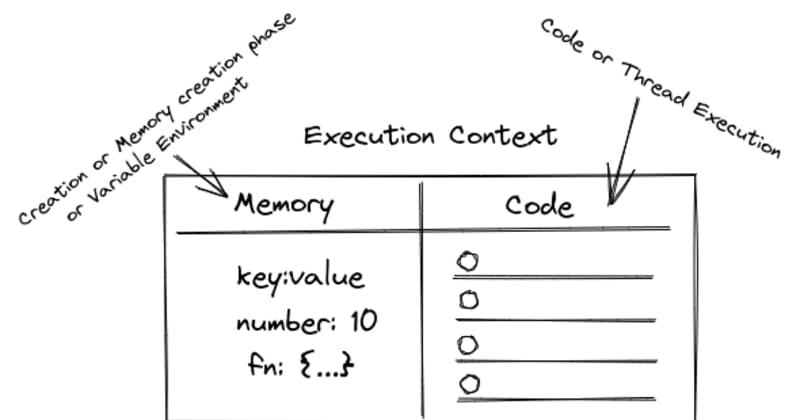What is an Execution Context?
So, what is an execution context? Whenever you write some code, your code is in a space that space is called the “execution context”.
“ Everything in JavaScript happens inside an Execution Context.”
JavaScript is a synchronous, single-threaded language. It is because it can only execute one command at a time and in a specific order.
You can consider the Execution context as a big container, invoked when the browser wants to run javascript code.
In this container, there are two components
- Memory component
- Code component
The memory component is also known as the variable environment. In this memory component, variables and functions are stored as key-value pairs.
A code component is a place in the container where code is executed one line at a time. This code component also has a fancy name, namely ‘Thread of Execution'. I think it sounds cool!

Execution of the code
var a = 2;
var b = 4;
var sum = a + b;
console.log(sum);
Let’s take a simple example,
In this simple example, we initialize two variables, a and b, and store 2 and 4, respectively.
Then we add the value of a and b and store it in the sum variable.
The browser creates a global execution context with two components, namely memory and code components.
The Browser will execute the JavaScript code in two-phase
1> Memory Creation Phase
2> Code Execution Phase
Memory Creation Phase
In the memory creation phase, JavaScript will scan through all the code and allocate memory to all the variables and functions in the code.For variables, JavaScript will store undefined in the memory creation phase, and for functions, it will keep the entire function code, which we will be looking at the following example.

Code Execution Phase
Now, in the 2nd phase, i.e. code execution, it starts going through the whole code line by line.
As it encounters var a = 2, it assigns 2 to ‘a’ in memory. Until now, the value of ‘a’ was undefined.
Similarly, it does the same thing for the b variable. It assigns 4 to ‘b’. Then it calculates and stores the value of the sum in memory which is 6. Now, in the last step, it prints the sum value in the console and then destroys the global execution context as our code is finished.
Types of Execution Context
There are three types of execution context in JavaScript.
1 Global Execution Context
After loading and parsing the JavaScript code, the JS engine enters the default execution environment. The window object and the
this objectare created in the global memory by default once the JS engine is inside the global execution environment.The window object refers to or is connected to the global object, which is always created before the JS engine enters the global execution environment and contains properties and methods like localStorage, innerWidth, and event handlers, among others.
The
thisobject (in the global execution context) is an object that points to or is hooked to the window object.So, what happens if the JavaScript code has declared variables and functions?
It will search all of the code for all variable and function declarations (variables and functions that are not nested to any other function) and place them in the global memory alongside the window and
this object.
2 Local/Function Execution Context
Every time a function is invoked, a brand new execution context is created for that function. Each function has its own execution context, but it’s created when the function is invoked or called. There can be any number of function execution contexts. Whenever a new execution context is created, it goes through a series of steps in a defined order.
3. Eval Function Execution Context
The eval function is a function that should be avoided at all costs. An execution context is constructed and pushed into the call stack whenever the JS engine encounters an eval() function. It evaluates a string that is passed as an argument.
As a result, if you mistakenly sent harmful code as an argument, or if a hostile party uses this area of your code, your website might be badly harmed. This function is not recommended because there are better alternatives.
